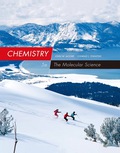
Concept explainers
(a)
Interpretation:
The
(a)
Answer to Problem 112QRT
The
Explanation of Solution
The equation for the equilibrium can be written as given below.
The acid ionization constant for the above equation can be written as given below.
A table can be set up as given below.
The concentration of
By substituting all the values in the above equation, the value of
The
Therefore, the
(b)
Interpretation:
It has to be decided how many times
(b)
Answer to Problem 112QRT
The concentration of
Explanation of Solution
The equation for the equilibrium can be written as given below.
The acid ionization constant for the above equation can be written as given below.
A table can be set up as given below.
The concentration of
By substituting all the values in the above equation, the value of
Assuming x is very small, it can be written as
Then,
So, the concentration of
The number of times more
Therefore, the concentration of
Want to see more full solutions like this?
Chapter 14 Solutions
EBK CHEMISTRY: THE MOLECULAR SCIENCE
- The pH of a 0.10-M solution of propanoic acid, CH3CH2COOH, a weak organic acid, is measured at equilibrium and found to be 2.93 at 25 °C. Calculate the Ka of propanoic acid.arrow_forwardWhat is the freezing point of vinegar, which is an aqueous solution of 5.00% acetic acid, HC2H3O2, by mass (d=1.006g/cm3)?arrow_forwardLactic acid, C3H6O3, occurs in sour milk as a result of the metabolism of certain bacteria. Calculate the pH of a solution of 56. mg lactic acid in 250. mL water. Ka for D-lactic acid is 1.5 × 10−4.arrow_forward
- Estimate the pH that results when the following two solutions are mixed. a) 50 mL of 0.3 M CH3COOH and 50 mL of 0.4 M KOH b) 100 mL of 0.3 M CH3COOH and 50 mL of 0.4 M NaOH c) 150 mL of 0.3 M CH3COOH and 100 mL of 0.3 M Ba(OH)2 d) 200 mL of 0.3 M CH3COOH and 100 mL of 0.3 M Ba(OH)2arrow_forwardWhat is the pH of a solution obtained by mixing 235 mL of NaOH with a pH of 11.57 and 316 mL of Sr(OH)2 with a pH of 12.09? Assume that volumes are additive.arrow_forwardCalculate the pH of a solution prepared by mixing 49.0 mL of butyric acid, HC4H7O2, with 6.15 g of KOH in water. The following data about butyric acid may be helpful: density=0.9595g/mL;K a =1.54105arrow_forward
- Consider 0.10 M solutions of the following compound: AlCl3, NaCN, KOH, CsClO4, and NaF. Place these solutions in order of increasing pH.arrow_forwardUsing the diagrams shown in Problem 10-117, which of the solutions would have the greatest buffer capacity, that is, greatest protection against pH change, when the following occurs? a. A strong acid is added to the solution. b. A strong base is added to the solution.arrow_forward
 Chemistry: The Molecular ScienceChemistryISBN:9781285199047Author:John W. Moore, Conrad L. StanitskiPublisher:Cengage Learning
Chemistry: The Molecular ScienceChemistryISBN:9781285199047Author:John W. Moore, Conrad L. StanitskiPublisher:Cengage Learning Chemistry: Principles and PracticeChemistryISBN:9780534420123Author:Daniel L. Reger, Scott R. Goode, David W. Ball, Edward MercerPublisher:Cengage Learning
Chemistry: Principles and PracticeChemistryISBN:9780534420123Author:Daniel L. Reger, Scott R. Goode, David W. Ball, Edward MercerPublisher:Cengage Learning Chemistry & Chemical ReactivityChemistryISBN:9781337399074Author:John C. Kotz, Paul M. Treichel, John Townsend, David TreichelPublisher:Cengage Learning
Chemistry & Chemical ReactivityChemistryISBN:9781337399074Author:John C. Kotz, Paul M. Treichel, John Townsend, David TreichelPublisher:Cengage Learning ChemistryChemistryISBN:9781305957404Author:Steven S. Zumdahl, Susan A. Zumdahl, Donald J. DeCostePublisher:Cengage Learning
ChemistryChemistryISBN:9781305957404Author:Steven S. Zumdahl, Susan A. Zumdahl, Donald J. DeCostePublisher:Cengage Learning Chemistry: An Atoms First ApproachChemistryISBN:9781305079243Author:Steven S. Zumdahl, Susan A. ZumdahlPublisher:Cengage Learning
Chemistry: An Atoms First ApproachChemistryISBN:9781305079243Author:Steven S. Zumdahl, Susan A. ZumdahlPublisher:Cengage Learning





